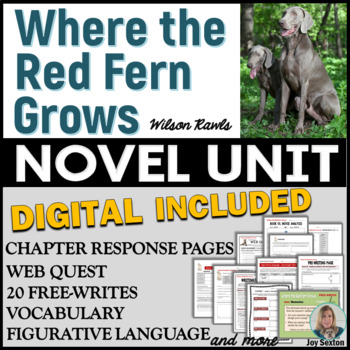Where the Red Fern Grows Novel Study Unit - Print & DIGITAL
- Zip
- Google Apps™

What educators are saying
Description
Where the Red Fern Grows Novel Unit will instantly engage your students with beautifully-designed activities that allow for deeper thinking! Now includes both a print and digital version! Students analyze the text on Chapter-by-Chapter Response Pages, complete a fun Web Quest, and express themselves with journal-style Free-Writes. Specific standards-based skills are addressed throughout the unit, and a full answer key is included.
The DIGITAL version offers colorful slides that allow students to type their responses into text boxes. Tests and vocabulary quizzes are accessed with links to Google Forms, and are self-grading.
To access the DIGITAL version of this resource, you will find:
--a PDF containing links to every resource listed for the unit
--directions for uploading the resources and using them with students
With both a print-and-go version AND digital, you'll be equipped for all teaching situations! Plus, you'll be able to differentiate according to your students' needs.
---------------------------------------------------------------------------------------------------------------------------------
This Resource Contains:
1. PRE-READING WEB QUEST – Students access background information on topics related to the novel--includes five engaging websites with questions for each.
2. CHAPTER-BY-CHAPTER STUDENT RESPONSE PAGES—Each page presents a variety of prompts regarding specific characters, settings, events, significant quotations, etc. Students cite text-based evidence to analyze what the text says, make inferences, analyze figurative language, dialogue, author’s word choice, etc. Students enjoy some discussion around the topics on these response pages with a partner or in small groups. A great tool for getting kids to talk about the book but also be responsible for their own comprehension and thoughtful response.
3. RED FERN FREE-WRITES - 20 Journal-style writing prompts on attractive slides (one for every chapter) and a Free-Writes Log for student responses. Great discussion starters!
4. VOCABULARY – Eight pages focus on 40 words from the novel. Students study the given definitions, fit words correctly into sentences that are provided, and choose some words to illustrate meanings.
5. VOCABULARY QUIZZES – Four Vocabulary quizzes focus on ten words per quiz. Digital version created in Google Forms (not Microsoft compatible).
6. FIGURATIVE LANGUAGE SCAVENGER HUNT - Students find examples of simile, metaphor, personification, and hyperbole, and analyze figurative meanings (works well with a partner).
7. FIGURATIVE LANGUAGE AND MEANING - Students are given examples of figurative language and must decide which type and then analyze. (Created as an option for teachers who are not using the Perma-Bound version of the book and therefore would not be able to use the Figurative Language Scavenger Hunt)
8. DETERMINING THEMES IN THE NOVEL – This organizer leads the students to determine two main themes after examining some of the main character’s experiences involving several “theme topics.”
9. TYPES OF CONFLICT CHART– Students determine one conflict for each type: Man vs. Man, Nature, Society, and Self, and explain how each conflict is resolved.
10. RED FERN WRITING TOPICS – End-of-novel writing assignment offers 3 choices (for differentiation) and requires one full typed page with visuals. Includes a PRE-WRITING ORGANIZER for each topic choice and an optional WRITING RUBRIC for grading. This is a writing process piece that students enjoy and results are display-worthy!
11. TWO TESTS - A 20-question test based on Chapters 1-9 and a 20-question test based on Chapters 10-end. Digital versions created in Google Forms (not Microsoft compatible).
12. FULL ANSWER KEY
13. TEACHER GUIDE and ELA Standards
-----------------------------------------------------------------------------------------------------------------------------
Standards-Based Literacy Skills students will practice:
--Citing text-based details to analyze what the text says regarding
characters, setting, and events
--Analyzing the development of theme
--Analyzing specific lines of dialogue
--Making inferences
--Determining the meanings of new words; connotation
--Analyzing figurative language
--Author's tone; Mood
--Providing a summary of text
--Narrative writing
--Conducting short research
--Compare/contrast a written story to its filmed version
--Write routinely over shorter time frames
This novel unit will take you all the way through Where the Red Fern Grows, keeping students on track with rigorous, standards-aligned learning activities. The resource is attractively designed for student engagement.
Please open the Preview.
Thank you! -- Joy
You might also like teaching with:
Short Response for ANY Literature - DIGITAL Distance Learning- Differentiated
Character Traits Essay – Informative Writing
Literature Stations with Task Cards for ANY Novel, Drama, or Story
---Yes! Join my list to receive Teaching Tips, New Product Updates, and FREEBIES from Joy





